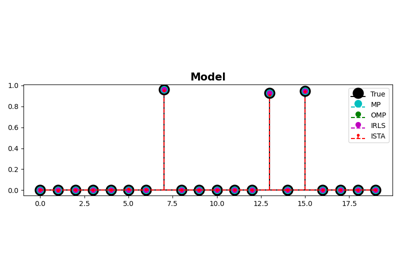pylops.optimization.sparsity.OMP¶
-
pylops.optimization.sparsity.OMP(Op, data, niter_outer=10, niter_inner=40, sigma=0.0001, normalizecols=False, show=False)[source]¶ Orthogonal Matching Pursuit (OMP).
Solve an optimization problem with \(L^0\) regularization function given the operator
Opand datay. The operator can be real or complex, and should ideally be either square \(N=M\) or underdetermined \(N<M\).Parameters: - Op :
pylops.LinearOperator Operator to invert
- data :
numpy.ndarray Data
- niter_outer :
int, optional Number of iterations of outer loop
- niter_inner :
int, optional Number of iterations of inner loop. By choosing
niter_inner=0, the Matching Pursuit (MP) algorithm is implemented.- sigma :
list Maximum \(L^2\) norm of residual. When smaller stop iterations.
- normalizecols :
list, optional Normalize columns (
True) or not (False). Note that this can be expensive as it requires applying the forward operator \(n_{cols}\) times to unit vectors (i.e., containing 1 at position j and zero otherwise); use only when the columns of the operator are expected to have highly varying norms.- show :
bool, optional Display iterations log
Returns: - xinv :
numpy.ndarray Inverted model
- iiter :
int Number of effective outer iterations
- cost :
numpy.ndarray, optional History of cost function
See also
ISTA- Iterative Shrinkage-Thresholding Algorithm (ISTA).
FISTA- Fast Iterative Shrinkage-Thresholding Algorithm (FISTA).
SPGL1- Spectral Projected-Gradient for L1 norm (SPGL1).
SplitBregman- Split Bregman for mixed L2-L1 norms.
Notes
Solves the following optimization problem for the operator \(\mathbf{Op}\) and the data \(\mathbf{d}\):
\[\|\mathbf{x}\|_0 \quad \text{subject to} \quad \|\mathbf{Op}\,\mathbf{x}-\mathbf{b}\|_2^2 \leq \sigma^2,\]using Orthogonal Matching Pursuit (OMP). This is a very simple iterative algorithm which applies the following step:
\[\begin{split}\DeclareMathOperator*{\argmin}{arg\,min} \DeclareMathOperator*{\argmax}{arg\,max} \Lambda_k = \Lambda_{k-1} \cup \left\{\argmax_j \left|\mathbf{Op}_j^H\,\mathbf{r}_k\right| \right\} \\ \mathbf{x}_k = \argmin_{\mathbf{x}} \left\|\mathbf{Op}_{\Lambda_k}\,\mathbf{x} - \mathbf{b}\right\|_2^2\end{split}\]Note that by choosing
niter_inner=0the basic Matching Pursuit (MP) algorithm is implemented instead. In other words, instead of solving an optimization at each iteration to find the best \(\mathbf{x}\) for the currently selected basis functions, the vector \(\mathbf{x}\) is just updated at the new basis function by taking directly the value from the inner product \(\mathbf{Op}_j^H\,\mathbf{r}_k\).In this case it is highly reccomended to provide a normalized basis function. If different basis have different norms, the solver is likely to diverge. Similar observations apply to OMP, even though mild unbalancing between the basis is generally properly handled.
- Op :
